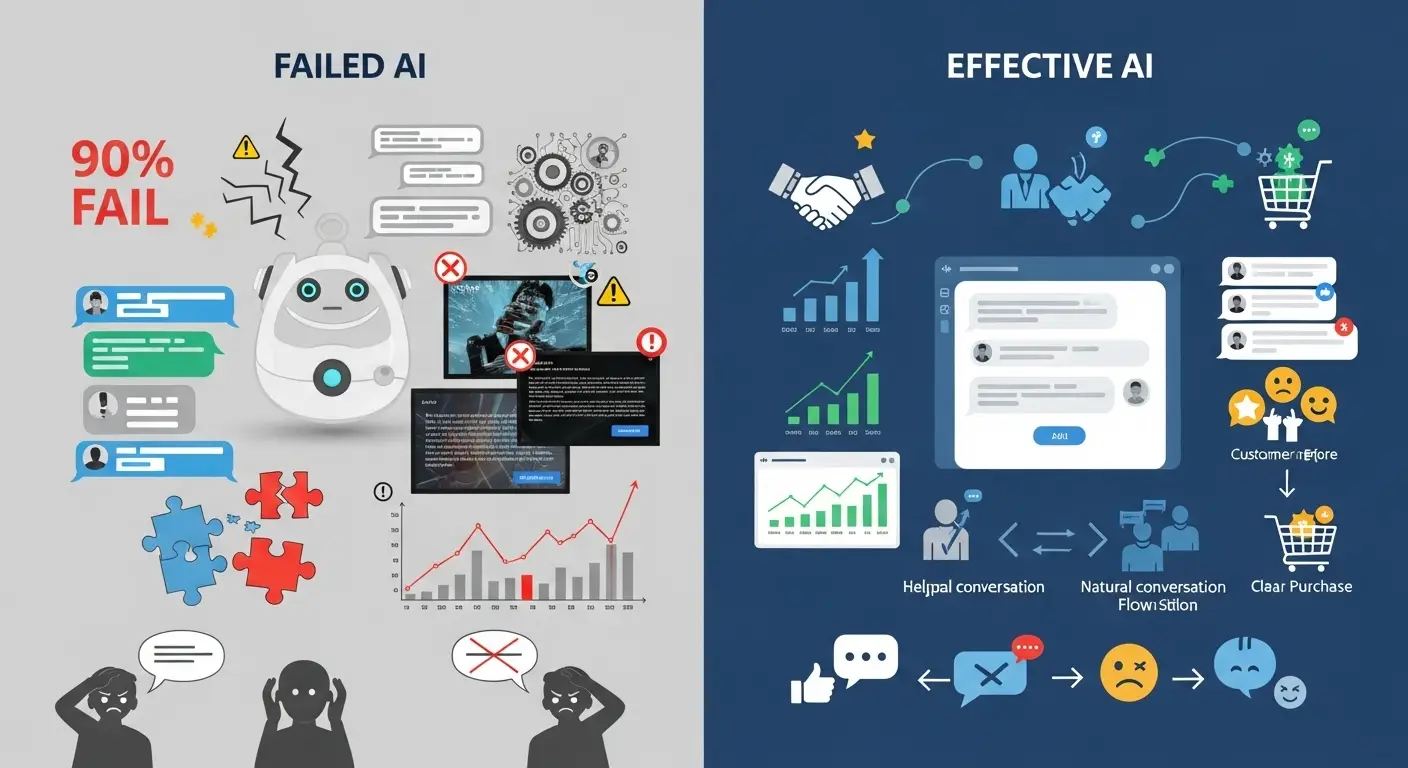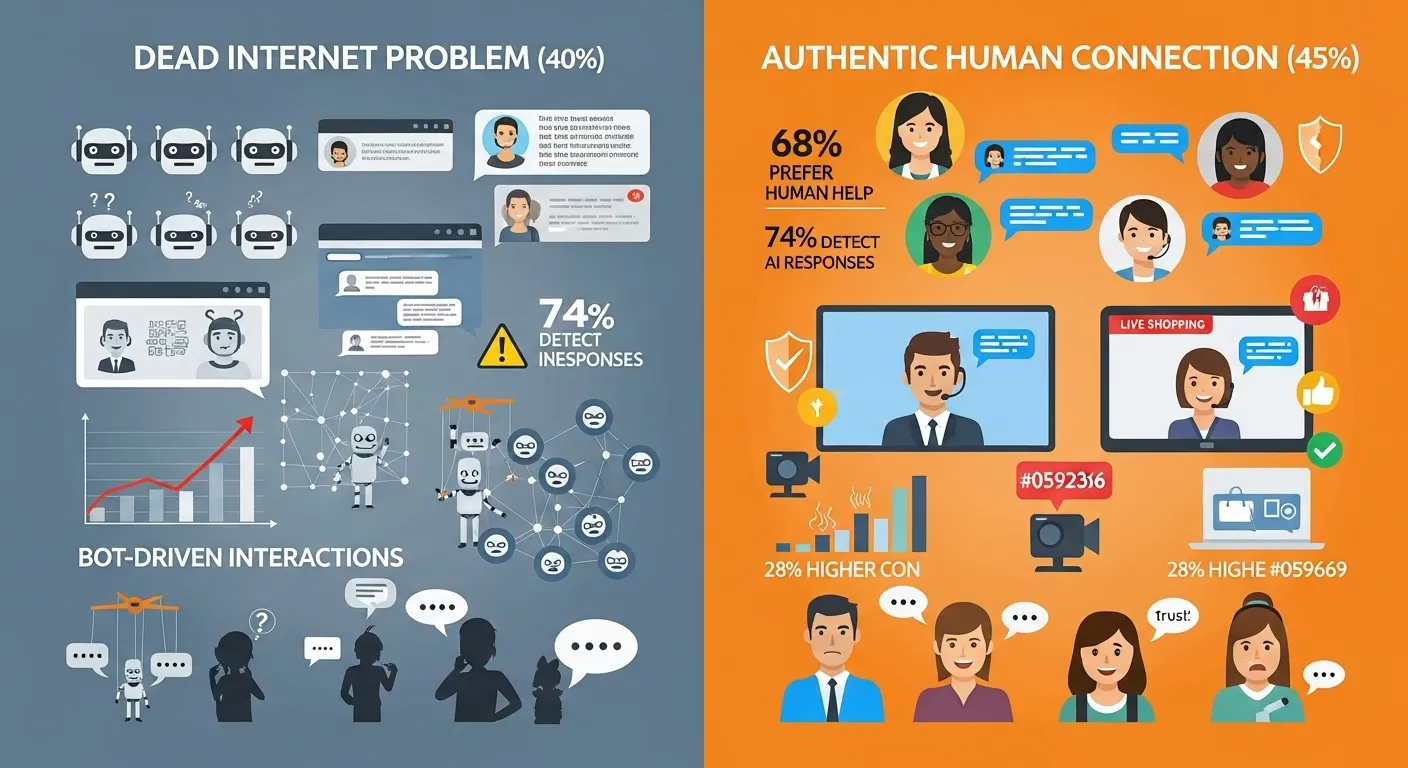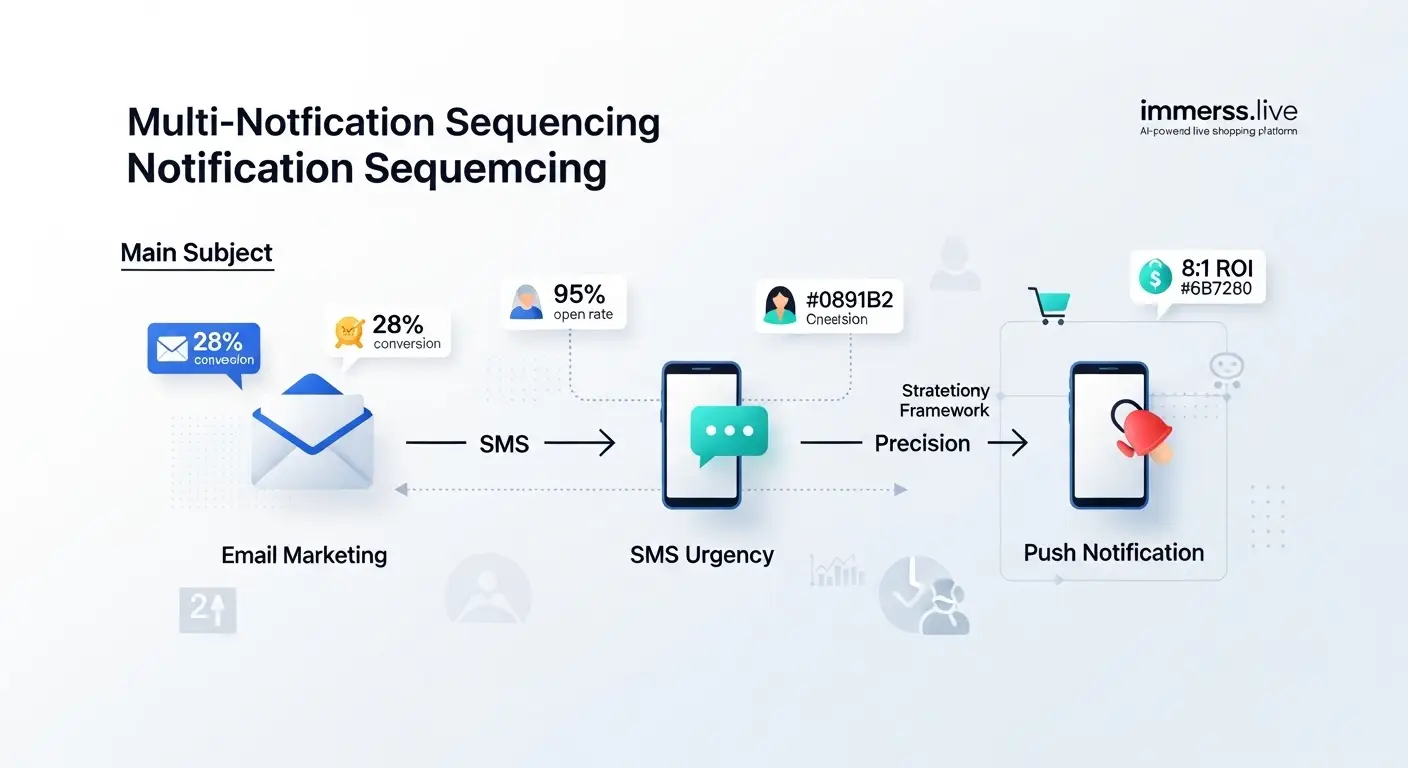Why 90% of AI Marketing Features Fail (And How to Build AI That Actually Works)
What if I told you that the majority of AI-powered marketing features launched in 2024 were quietly removed or abandoned within six months? A recent candid discussion on r/marketing from a software engineer revealed a harsh truth: “I killed an AI feature because it doesn’t actually help.” His experience building an AI-powered social media content generator exposed a fundamental problem plaguing the industry—AI implementations that sound impressive in marketing copy but fail to deliver genuine customer value.
This developer’s decision to prioritize Pinterest integrations and detailed analytics over an AI feature that “just straight sucks” highlights a critical disconnect between AI hype and practical effectiveness. His observation that “adding AI-powered or whatever just became a marketing default for startups” strikes at the heart of why so many AI implementations fail to meet customer expectations.
This comprehensive analysis explores why most AI marketing features disappoint users, examines the principles behind successful AI implementation, and provides actionable frameworks for building AI solutions that genuinely enhance customer experiences rather than simply checking marketing boxes.
The Current State of AI Marketing Implementation
The AI Hype Cycle Reality Check
The marketing technology landscape has become saturated with AI-powered solutions promising revolutionary results. Industry research indicates that 87% of marketing tools now feature some form of AI functionality, yet customer satisfaction scores for these features remain consistently below traditional feature sets. This paradox reveals a fundamental misalignment between AI capabilities and customer needs.
Most AI implementations follow a predictable pattern: initial excitement about automation possibilities, rapid development focused on technical feasibility rather than user value, and eventual disappointment when the AI produces generic, obviously artificial output. The Reddit developer’s experience mirrors countless similar stories across the industry—technically functional AI that fails the practical effectiveness test.
The root cause often lies in the approach to AI implementation. Many companies begin with the question “How can we add AI?” rather than “What specific customer problem can AI uniquely solve?” This backward approach leads to AI features that exist primarily for marketing differentiation rather than genuine utility.
The Content Quality Problem
AI-generated content represents one of the most visible failures in marketing AI implementation. Despite significant advances in language models, AI-produced marketing content consistently struggles with authenticity, brand voice consistency, and contextual relevance. The challenge extends beyond technical limitations to fundamental questions about what customers actually value in brand communications.
Research from content marketing platforms shows that AI-generated social media posts receive 34% lower engagement rates compared to human-created content, even when technically well-written. This engagement gap persists across industries and platforms, suggesting that audiences can intuitively detect artificial content regardless of its technical quality.
The problem becomes more pronounced when AI systems attempt to replicate brand personality or emotional resonance. While AI excels at information processing and pattern recognition, it struggles with the nuanced understanding of brand context, audience sentiment, and cultural relevance that effective marketing requires.
Implementation Shortcuts and Their Consequences
Many AI implementations fail because they prioritize speed to market over thorough problem analysis. The pressure to include AI features often leads to shortcuts that compromise effectiveness: generic prompting instead of custom training, one-size-fits-all solutions instead of context-specific approaches, and feature deployment without adequate testing against real customer workflows.
These shortcuts create AI solutions that work in controlled environments but fail under real-world conditions. Customer feedback consistently reveals that AI features feel disconnected from actual business processes, require extensive manual correction, or produce output that needs complete rewriting to be usable.
What Makes AI Implementation Actually Effective
Problem-First AI Development
Successful AI implementations begin with deep understanding of specific customer pain points rather than technical capabilities. This approach requires extensive customer research, workflow analysis, and clear definition of success metrics before any AI development begins.
The most effective AI marketing tools solve clearly defined problems: reducing response time for customer inquiries, personalizing product recommendations based on behavior patterns, or automating routine tasks that consume disproportionate human resources. These solutions focus on augmenting human capabilities rather than replacing human judgment.
Customer-Centric Design Principles drive successful AI implementation. Rather than building AI systems that demonstrate technical sophistication, effective solutions prioritize user experience, workflow integration, and measurable business outcomes. This approach often leads to simpler AI implementations that deliver greater practical value.
Context-Aware AI Architecture
Sophisticated AI implementations understand context at multiple levels: business context (industry, company size, competitive landscape), user context (role, expertise level, current objectives), and situational context (time constraints, available resources, specific challenges). This multi-layered understanding enables AI systems to provide relevant, actionable recommendations rather than generic suggestions.
Context awareness requires significant upfront investment in data architecture, user research, and system design. However, this foundation enables AI systems to learn and improve over time, becoming more valuable as they accumulate experience with specific customer workflows and preferences.
Adaptive Learning Systems represent the next evolution in AI effectiveness. These systems continuously refine their output based on user feedback, business outcomes, and changing market conditions. Rather than static AI models, they evolve to match changing customer needs and business environments.
Human-AI Collaboration Models
The most successful AI implementations embrace human-AI collaboration rather than attempting full automation. This approach recognizes that AI excels at data processing, pattern recognition, and routine tasks, while humans provide creativity, strategic thinking, and contextual judgment.
Effective collaboration models provide AI assistance that enhances human decision-making without replacing human oversight. Users maintain control over final outputs while benefiting from AI-powered insights, suggestions, and automation of time-consuming tasks.
Transparent AI Decision-Making builds user trust and enables effective collaboration. When users understand how AI systems reach conclusions and can easily modify or override AI recommendations, they’re more likely to embrace AI assistance as a valuable tool rather than a frustrating limitation.
The Authenticity Challenge in Conversational AI
Beyond Generic Responses
The challenge of creating authentic AI interactions extends far beyond content generation to the fundamental nature of customer communication. Generic AI responses, regardless of technical sophistication, fail to create the personal connections that drive customer loyalty and purchasing decisions.
Authentic AI interactions require deep understanding of customer intent, emotional context, and individual preferences. This understanding enables AI systems to provide responses that feel naturally helpful rather than obviously automated. The difference lies not in the complexity of the AI model but in the depth of customer insight integrated into the system.
Conversational Intelligence represents a significant advancement over traditional chatbot technology. Rather than following predetermined scripts, intelligent conversation systems understand context, maintain continuity across interactions, and adapt their communication style to individual customer preferences.
Building Trust Through Transparency
Customer trust in AI systems depends heavily on transparency about AI involvement and clear demonstration of value. Customers respond positively to AI assistance when they understand how it enhances their experience rather than feeling like they’re interacting with a deceptive substitute for human service.
Effective AI implementations clearly communicate when AI assistance is involved while demonstrating immediate, tangible benefits. This transparency builds confidence in the AI system and encourages customers to engage more openly, providing better data for continuous improvement.
Seamless Human Handoffs ensure that AI assistance enhances rather than constrains customer service quality. When AI systems can intelligently identify situations requiring human expertise and facilitate smooth transitions, they become valuable tools for improving overall service efficiency.
Strategic Framework for Effective AI Implementation
Value-Driven Development Process
Successful AI implementation follows a structured process that prioritizes customer value over technical novelty. This framework begins with comprehensive customer research to identify specific pain points that AI can uniquely address, followed by iterative development that continuously validates effectiveness against real customer needs.
Customer Journey Mapping reveals opportunities where AI can provide meaningful assistance without disrupting natural interaction flows. Rather than forcing customers to adapt to AI limitations, effective implementations integrate AI assistance into existing customer behaviors and preferences.
Measurable Impact Metrics guide development decisions and ensure that AI features deliver quantifiable business value. These metrics extend beyond technical performance to include customer satisfaction, task completion rates, and business outcome improvements.
Integration and Scalability Considerations
Effective AI implementations consider integration with existing systems and scalability requirements from the initial design phase. AI features that require significant workflow changes or operate in isolation from other business systems often fail to achieve adoption regardless of their technical capabilities.
API-First Architecture enables AI features to integrate seamlessly with existing business systems, customer databases, and workflow tools. This integration ensures that AI assistance feels like a natural extension of existing processes rather than a separate system requiring parallel management.
Scalable Learning Systems adapt to growing data volumes and evolving customer needs without requiring complete system redesigns. This scalability enables AI implementations to improve over time and accommodate business growth without losing effectiveness.
Performance Monitoring and Optimization
Continuous monitoring and optimization distinguish successful AI implementations from failed experiments. This process requires comprehensive tracking of both technical performance and customer satisfaction metrics, with regular analysis to identify improvement opportunities.
Real-Time Feedback Integration enables AI systems to learn from customer interactions and improve response quality continuously. This feedback loop ensures that AI assistance becomes more valuable over time rather than remaining static.
A/B Testing Frameworks validate AI effectiveness against traditional approaches and guide optimization decisions based on empirical data rather than assumptions about customer preferences.
The Future of Authentic AI in Customer Experience
Emerging Trends in Conversational Commerce
The evolution toward more sophisticated conversational AI reflects growing customer expectations for personalized, intelligent assistance throughout the shopping journey. Modern customers expect AI systems to understand context, remember preferences, and provide relevant recommendations that genuinely enhance their experience.
Predictive Customer Assistance represents the next frontier in AI-powered customer experience. These systems anticipate customer needs based on behavior patterns, purchase history, and situational context, enabling proactive assistance that feels naturally helpful rather than intrusive.
Omnichannel AI Integration ensures consistent AI assistance across all customer touchpoints, from initial product discovery through post-purchase support. This consistency builds familiarity and trust while providing comprehensive assistance throughout the customer journey.
Building Sustainable AI Advantage
Companies that successfully implement AI gain sustainable competitive advantages through continuously improving customer experiences and operational efficiency. However, this advantage requires ongoing investment in AI development, customer research, and system optimization.
The most successful AI implementations become more valuable over time as they accumulate customer data and refine their understanding of individual preferences. This learning advantage creates barriers to competitive imitation while continuously improving customer satisfaction.
Customer-Centric AI Development focuses on solving real customer problems rather than showcasing technical capabilities. This approach builds stronger customer relationships and drives measurable business results that justify continued AI investment.
Modern conversational commerce platforms demonstrate how AI can enhance rather than replace human interaction, providing intelligent assistance that feels natural and helpful. The key lies in understanding that effective AI amplifies human capabilities rather than attempting to replicate them artificially.
Book Your Live Demo to experience how properly implemented AI assistance can transform customer interactions from generic chatbot exchanges into personalized shopping experiences that drive genuine engagement and measurable results.
Ready to implement AI that actually works? Our conversational commerce experts can show you how to build AI assistance that enhances customer experience while driving measurable business outcomes.



